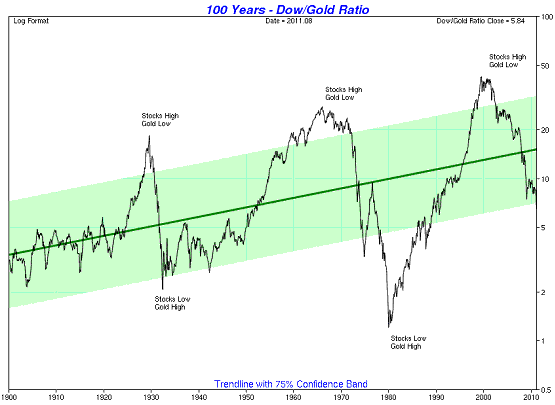Gold: The Big Picture
Steve Saville
email: sas888_hk@yahoo.com
Posted Aug 30, 2011
Below is an excerpt from a commentary originally posted at www.speculative-investor.com on 25th August 2011.
With gold having 'gone parabolic' in the weeks leading up to this week's top, the question arises as to whether or not gold's long-term bull market has ended. After all, upside blow-offs usually occur during the final phases of major rallies.
To help answer the question we present, below, a chart of the Dow/Gold ratio courtesy of sharelynx.com. This chart shows that the ratio recently fell to near the bottom of its ultra-long-term channel, which indicates that gold is no longer cheap relative to the Dow Industrials Index. The chart also shows that gold is nowhere near as expensive as it was in January of 1980, when the ratio hit 1.0. In order for the ratio to return to its 1980 trough, the US$ gold price would have to rise by an additional 500% relative to the Dow.

There is no guarantee that gold will become as expensive this time around as it did in 1980, but we can't think of a good reason why it won't. The reality is that the economies of most developed-world countries are structurally a lot weaker today than they were in 1980, thanks to decades of resource misallocation and debt accumulation prompted by government intervention and central bank manipulation. Considering the current economic backdrop and the fact that central banks and governments appear to be accelerating down the wrong path, a good argument could be made for an eventual Dow/Gold ratio of less than 1.
When considered alongside the economic situation and policy direction, the current position of the Dow/Gold ratio suggests that gold's bull market has plenty of room to run.
The money-supply backdrop is another good reason to believe that gold's bull market is not yet close to an end. Specifically, the history of the past 50 years tells us that gold tends to peak in price a few years after a peak in the TMS year-over-year growth rate. For example, the TMS growth rate peaked in early 1977 and went negative in early 1979, but gold didn't reach its ultimate top until early 1980. The downtrend in money-supply growth that began in 1977 set the stage for the eventual end of the 1970s bull market in gold, but anyone who sold their gold during the early part of the monetary contraction missed the largest 2-year gold rally in history.
The most recent major peak in the TMS growth rate occurred in November of 2009, but the monetary inflation rate has recently moved back up to near its 2009 high. This suggests to us that even if the rate of money-supply growth were to immediately begin trending downward, we would still be a few years away from gold's ultimate price top.
The bottom line is that it's not appropriate right now to be planning for an imminent end to gold's long-term bull market. However, gold recently became sufficiently 'overbought' to enable an intermediate-term decline.
###
Steve Saville
 email: sas888_hk@yahoo.com email: sas888_hk@yahoo.com
Hong Kong Regular financial market forecasts and analyses are provided at our web site:
http://www.speculative-investor.com/new/index.html. We aren't offering a free trial subscription at this time, but free samples of our work (excerpts from our regular commentaries) can be viewed at: http://tsi-blog.com
Copyright ©2002-2019 speculative-investor.com All Rights Reserved. Saville Archives
321gold Ltd

|

